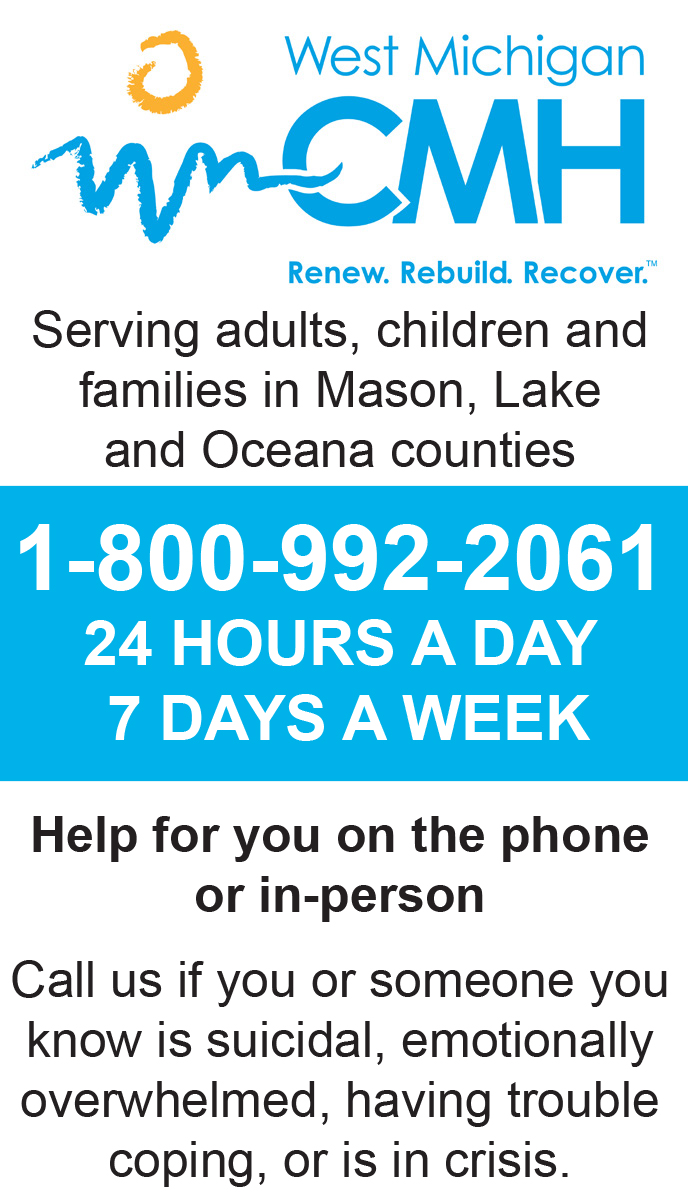 By Allison Scarbrough. OCP Editor.
By Allison Scarbrough. OCP Editor.
HART — At least 25 local emergency personnel participated in ice rescue training with members of the U.S. Coast Guard Saturday morning, Jan. 31, on Hart Lake.
Local firefighters, along with law enforcement and emergency medical personnel, took part in the annual training. Coast Guard staff showed the first responders how to rescue a person who falls through the ice. Participants wore dry suits that keep them warm and dry in the icy waters. Using a chainsaw, the firefighters cut a large hole through the ice, which is  approximately one-foot thick, near the boat launch at John Gurney Park.
approximately one-foot thick, near the boat launch at John Gurney Park.
The training is vital for first responders in this area Oceana County, which has numerous inland lakes used for ice fishing and other outdoor recreational activities.
Here are some cold, hard facts about ice safety from the DNR:
Things to consider before you go out:
-
Ice conditions vary from lake to lake. Find a good local source – a bait shop or fishing guide – that is knowledgeable about ice conditions on the lake you want to fish on.
-
Purchase a pair of ice picks or ice claws, which are available at most sporting goods stores.
-
Tell a responsible adult where you are going and what time to expect you back. Relaying your plan can help save your life if something does happen to you on the ice.
-
You can’t always tell the strength of ice simply by its look, its thickness, the temperature or whether or not it is covered with snow.
-
Clear ice that has a bluish tint is the strongest. Ice formed by melted and refrozen snow appears milky, and is very porous and weak.
-
Ice covered by snow always should be presumed unsafe. Snow acts like an insulating blanket and slows the freezing process. Ice under the snow will be thinner and weaker. A snowfall also can warm up and melt existing ice.
-
If there is slush on the ice, stay off. Slush ice is only about half as strong as clear ice and indicates the ice is no longer freezing from the bottom.
-
Be especially cautious in areas where air temperatures have fluctuated. A warm spell may take several days to weaken the ice; however, when temperatures vary widely, causing the ice to thaw during the day and refreeze at night, the result is a weak, “spongy” or honeycombed ice that is unsafe.
-
The DNR does not recommend the standard “inch-thickness” guide used by many anglers and snowmobilers to determine ice safety. A minimum of four inches of clear ice is required to support an average person’s weight on the ice, but since ice seldom forms at a uniform rate it is important to check ice thickness with a spud and ruler every few steps.
-
The DNR does not recommend taking a car or truck out onto the ice at any time.
-
If you are walking out onto a frozen body of water with a group, avoid crossing ice in a single file.
-
Never venture out alone without telling a responsible adult on shore your plans.
-
Test ice thickness with an ice spud before you settle on a spot.
-
If you are with a group, avoid standing together in a spot. Spread out.
-
Wear a life jacket and bright-colored clothing.
-
Take a cell phone for emergency use.
-
Look for large cracks or depressions in the ice and avoid those areas.
-
Remember ice does not form with uniform thickness on any body of water. Underwater springs and currents can wear thin spots on the ice.
-
Try to remain calm.
-
Don’t remove your winter clothing. Heavy clothes won’t drag you down, but instead can trap air to provide warmth and flotation. This is especially true with a snowmobile suit.
-
Turn in the water toward the direction you came from – that is probably the strongest ice.
-
If you have them, dig the points of the ice picks into the ice and, while vigorously kicking your feet, pull yourself onto the surface by sliding forward on the ice.
-
Roll away from the area of weak ice. Rolling on the ice will distribute your weight to help avoid breaking through again.
-
Get to shelter, heat, dry clothing and warm, non-alcoholic and non-caffeinated drinks.
-
Call 911 and seek medical attention if you feel disoriented, have uncontrollable shivering, or have any other ill effects that may be symptoms of hypothermia (the life-threatening drop in the body’s core temperature).




























 (1).gif)




















.png)














